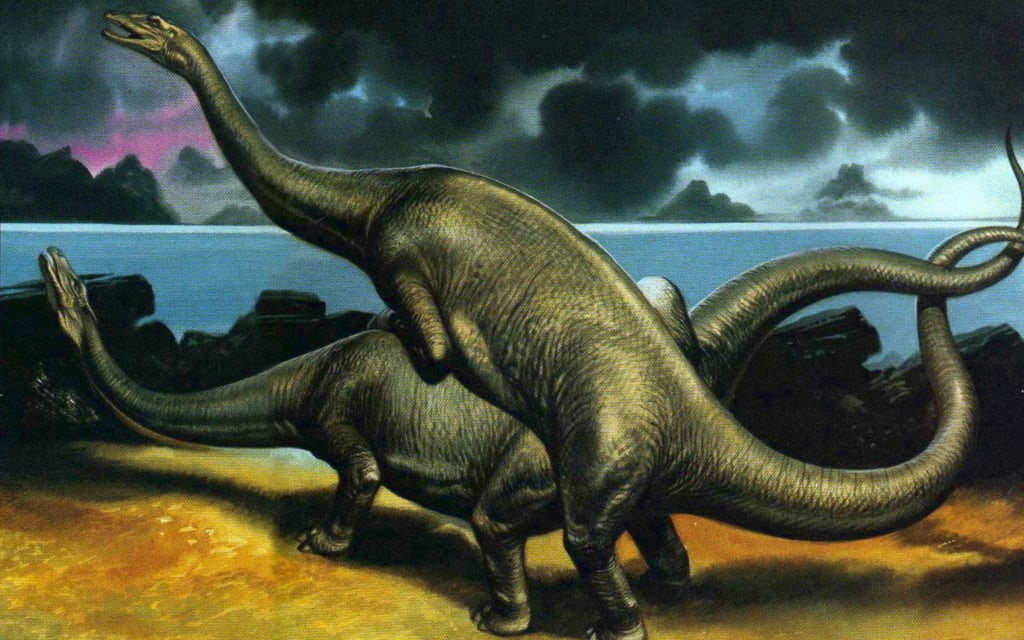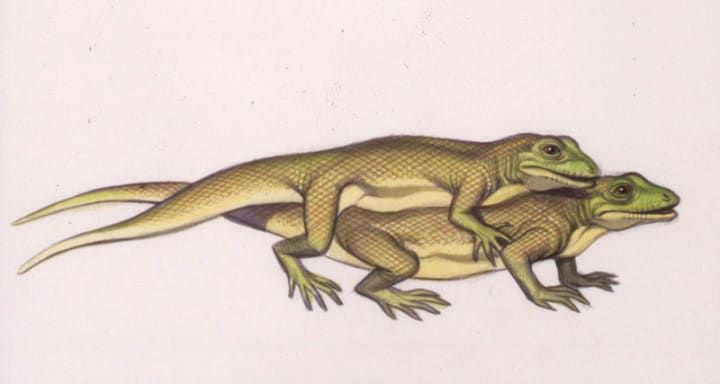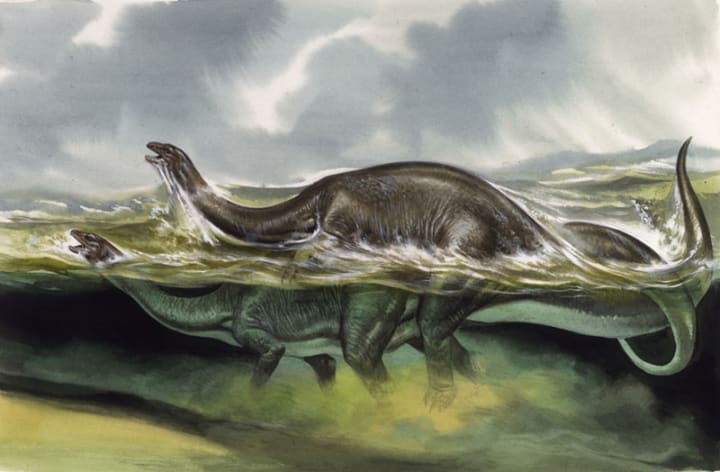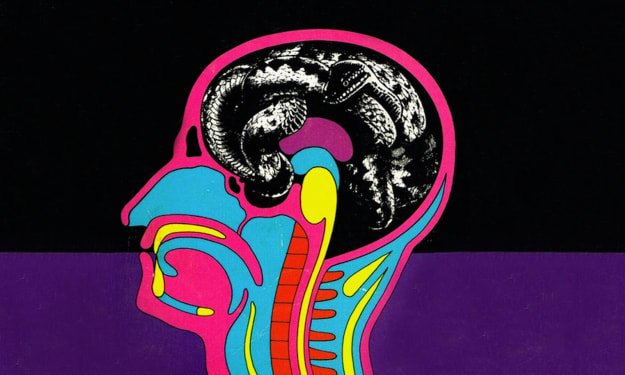How Dinosaurs Had Sex
Dinosaurs definitely reproduced but just how they engaged in sexual activity is a mystery even to those avid fans of jurassic park. more importantly, did the dinosaurs actually enjoy courting each other prior to sexual consummation?

I remember the moment I realized, as an adult, that I didn't know how birds had sex. I was gazing out the window of the library, considering a couple of sparrows on a telephone wire outside. They were sitting side-by-side, gazing outwards, as birds sometimes do, and I found myself wondering about their courtship. First came love, I mused, then...what? What happened between easeful flitting around on telephone wires and the domestic menage of egg-and-nest? I was shocked that I'd never even considered this question before.
Conveniently, when I came up against the bird-sex issue, I was in a library; when I finally dug up the answer, I was amazed to learn of cloacal kisses and strange corkscrew-shaped duck phalli. I should have gone one step further and traced those sparrows back to their more bodacious ancestors—dinosaurs. How did dinosaurs -- all spikes, muscle, and menace -- get down?
To answer this question, I've brought in an expert. Brian Switek is a freelance science writer specializing in evolution, paleontology, and natural history; his recent book, My Beloved Brontosaurus: On the Road with Old Bones, New Science, and Our Favorite Dinosaurs, includes, among other things, a scintillating chapter on prehistoric coitus. Get ready to learn more than you have ever wanted to know about dinosaur sex.
Are you ready to talk about dinosaur sex?
Switek: Absolutely.
It's one of things that I just never thought about until someone raised the question to me, "how do dinosaurs have sex?" It's not taught in school!
In America, it's the one-two punch, because you have to talk about sex and evolution, so I imagine that most school districts don't want anything to do with it.
It seems—and correct me if I'm wrong—that Beverly Halstead was the first paleontologist to really discuss the subject of dinosaur sex.
People like Henry Fairfield Osborn sort of considered it, as almost an aside. When Osborn first described Tyrannosaurus Rex, he said its small arms may have been used for some kind of tickling or hugging during copulation, but that's as far as he went. Halstead was the first person to take the idea and run with it, in his own idiosyncratic way. I don't know if he ever published anything technically, but he certainly gave a lot of talks about it, during which—very famously—he'd bring out his wife to help demonstrate the sexual positions the dinosaurs might have used. His book, aimed at younger audiences, called Ecology and Evolution of the Dinosaurs, just haspages of dinosaurs going at it. He really seemed to be quite tickled by the idea.
Maybe it was Halstead's outspoken technique, but it seems as though the notion of discussing dinosaur sex was somewhat shocking to the scientific community at the time. Do you feel like paleontologists have become more open to discussing dinosaur sex?
There are two aspects to this. First, it was not a topic for polite conversation. I mention this in my book, but during an early 20th century Antarctic Expedition, the naturalist on board, George Murray Levick, saw male penguins trying to mate with deceased female penguins, and he was so horrified that he wouldn't even distribute the monograph he was supposed to write about these penguins–the section on sexual reproduction was essentially cut out and only distributed to scientists that he could trust.
Even though that's not prehistoric dinosaurs per se, that's a watermark for naturalists in general: how they felt about talking about sexuality. It has certainly loosened up more now. And there's more to say. The other barrier was that there genuinely wasn't much to say. Unless you had a time machine, and, hopefully, a good amount of distance between yourself and the mating dinosaurs, there was no way you could say for sure.
So beyond it becoming a more respectable topic—baby dinosaurs have to come from somewhere—now, especially in the past few years, with the realization that birds are living dinosaurs, there is a lot more detail that can go into it. There are still a lot of mysteries involved with the mechanics, with the anatomy, but we can at least hypothesize, we can go about this in a much more rigorous way than I think was available to a lot of the naturalists of the earlier 20th century.

Is studying how birds reproduce the primary way that researchers look at this question? Is there anything in the fossil record that we can look at?
Not yet. I'm kind of holding out hope that someone will eventually find a dinosaur phallus or a dinosaur clitoris in the fossil record, or maybe some kind of soft tissue preservation that can give us some clue. We know a little about dinosaur reproduction from a pair of hips found in Mongolia, from an oviraptor-type dinosaur, that had two eggs in it. Because it had two eggs in it simultaneously, then we said, okay, these dinosaurs probably had two oviducts that each produced one egg at a time, and this corresponded to what was found in the nest…so we can say a little bit about the aftermath of the act, but it terms how they mated and what their genital anatomy was like, mostly we're in predictive stage. We don't have the fossils to tell.
I'm kind of hopeful that somebody will find some dinosaurs caught in the act. Recently, in the past year, there were turtles that were found—they were 50 million years old or so—that were fossilized, basically, in the mating position. They died while they were mating, and they were preserved with each other. It's not unreasonable to think that maybe that could happen for dinosaurs as well, but now the best we can do is: we know that birds are living dinosaurs. And we know that the closest living relatives to birds—and therefore the closest living cousins to the dinosaur group as a whole—are crocodiles and alligators. If you look at what crocodiles, alligators, and birds share in common, anatomically, in terms of their reproduction, you can make the reasonable assumption that this didn't evolve twice, that this goes back to a common ancestor, and that all those extinct dinosaurs fall into that bracket—this is something called extant phylogenic bracketing. Since male alligators have a prominent phallus and females have a prominent clitoris, and since birds of the basal group—birds like ostriches, ducks, and other waterfowl—have a similar setup, you can say, "okay, if archaic birds are like this, if crocodiles and alligators are like this, then there's a good chance that all those dinosaurs have a similar basic anatomical setup."
And that anatomical setup would be…a cloaca?
Rather than having a mammalian setup like ours, what they would have is—and this is seen in both crocodilians and birds—a sort of a cloaca. They'd have a one-stop orifice. It wouldn't be like budgies, or pigeons, or other birds that reproduce with a "cloacal kiss," with no external genitalia to move the sperm from male to female. Instead, we expect dinosaurs to be more like archaic birds, crocodiles, and alligators in that there would be some kind of organ to allow the passage of sperm between the two. How big that would have been, what it would look like—that's anybody's guess. Especially when you figure that there were over 1800 genera of dinosaurs during their prehistoric heyday, and you look at the differences in genital anatomy in birds today—even with just ducks, it's mind-boggling—so, you know, does Stegosaurus have a weird prehensile thing to get around all that armor? It's possible, we don't really know.

It seems like it would be a very precise and delicate act for such giant creatures to line up their organs. Do scientists do modeling to try and imagine the positions dinosaurs would take?
Yeah. It goes back to Beverly Halstead, who did it, basically, on paper. He expected that dinosaurs were very much like lizards and snakes; we now know that's not accurate, that they're much more like birds, so they didn't intertwine their tails, or float in mesozoic lakes having sauropod orgies like some of his illustrations. But we're still left with the problem getting the tail out of the way.
There are various books about this that have 2D illustrations; it's easy when it's flat, to move a leg out of way, because you're not dealing with the real animals. What I'm in the process of doing, or at least pushing for, is using laser-scanned skeletons to see what positions would actually work. To take some of these ideas: the leg-over-back idea, that the male would come up obliquely from behind and throw his hind leg over the female, or that they'd push their tails together, or that they might have faced away from each other and backed up like two docking spaceships, or that the female would have lain on her side and the male laid over the top of her.
Along with a paleontologist at the Museum of Natural History in Berlin, Heinrich Mallison, I'm taking laser-scanned skeletons that he has, virtual skeletons, to see what ranges of motion could actually have been possible. The first one that we've worked with was a cousin of the Stegosaurus that was much more spiky, with two-foot spikes over the hips and spikes all the way down the tail. We found that the leg-over-back thing wouldn't have worked; the male would have skewered himself immediately. And even if you took off all those spikes, he didn't have enough play in the hip socket to swing his leg out far enough. So it looks like the traditional position that Beverly Halstead proposed—it just didn't work from a biomechanical perspective.
That's something we never knew before, because nobody actually took it seriously enough to model with the actual skeletons. This isn't necessarily going to solve how dinosaurs did it—they might have done it in a way that's totally incomprehensible to us, although obviously they figured it out because they lived so long—but we can at least start to test some of these ideas that have been previously proposed.
How might they have dealt with the weight issue? We're talking about 100,000-pound animals. Wouldn't the male crush the female?
Not necessarily. There's a book—The Dynamics of Dinosaurs and Other Extinct Giants, by a biomechanics expert named R. McNeill Alexander—and he specifically talks about dinosaur reproduction. He says that during basic walking, dinosaurs were shifting their weight in such a way that they were only really supporting themselves on two legs at a time. They were putting a lot of stress on their hips, and it turns out that stress would be more or less equivalent, for a female dinosaur, to a male dinosaur resting some of his weight on her as they copulated. So his conclusion was that if dinosaurs could walk, they could mate.
We don't really know. But certainly it would have been a very delicate, potentially dangerous operation, specially for some of these very spiky, armored dinosaurs.
Well, sex in the animal kingdom is rarely pleasant.
Even without all the other stuff—all the anatomical issues—male sea otters regularly kill female sea otters as they're trying to mate. Mating amongst animals is not a romantic act. It's a terribly violent and horrifying event. Imagine Tyrannosaurus Rex trying to get it on: the female wanting to push off a male who's too young, or not desirable, but who is persistent. That could have ended in more than cuts and scrapes for both of them.
This gets into my next question, which is about courtship. Is there any scholarship on that subject?
Indirectly. You can't look at the actual behavior. Instead, a lot of people have looked at the horns of dinosaurs like Triceratops or Styracosaurus, the plates of Stegosaurus, even the necks of the big sauropod dinosaurs like Diplodocus or Apatosaurus, and said that maybe these are visual signals to show off: I am a virile male, or I am a female in good health. We don't really know—they were first interpreted as weapons—what these bizarre structures might have done in terms of advertisement. Even if you think of something like the neck of Apatosaurus: it doesn't have plates or spikes, but it does have a huge amount of prominent flesh just hanging out there. Maybe it was brightly colored during the mating season. Why not be a little bit flashy? There's an ongoing debate about that now, but unfortunately in terms of courtship, it's more imagination than anything else at this point.
And what an imagination that is.
We're dealing with some of the most spectacular animals that have ever existed. That's the thing about dinosaurs, at least for me. When I look at a dinosaur skeleton, I can't help but think, what did this animal look like? How did it behave? During the pivotal moments of its life, when it came time to mate and pass on its genes to the next generation, what did it actually do? It really to me, underscores, the wonderful ting about science—that it's the combination of the facts and clues we can pull from reality, and the best that we can imagine. And that's where dinosaurs exist, at the intersection between reality and imagination.
About the Creator
Claire Evans
Claire L. Evans is the lead singer of the pop duo YACHT. She lives in Los Angeles.






Comments
There are no comments for this story
Be the first to respond and start the conversation.